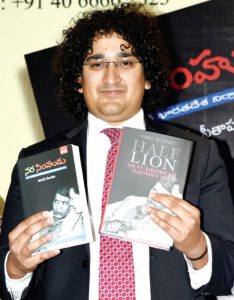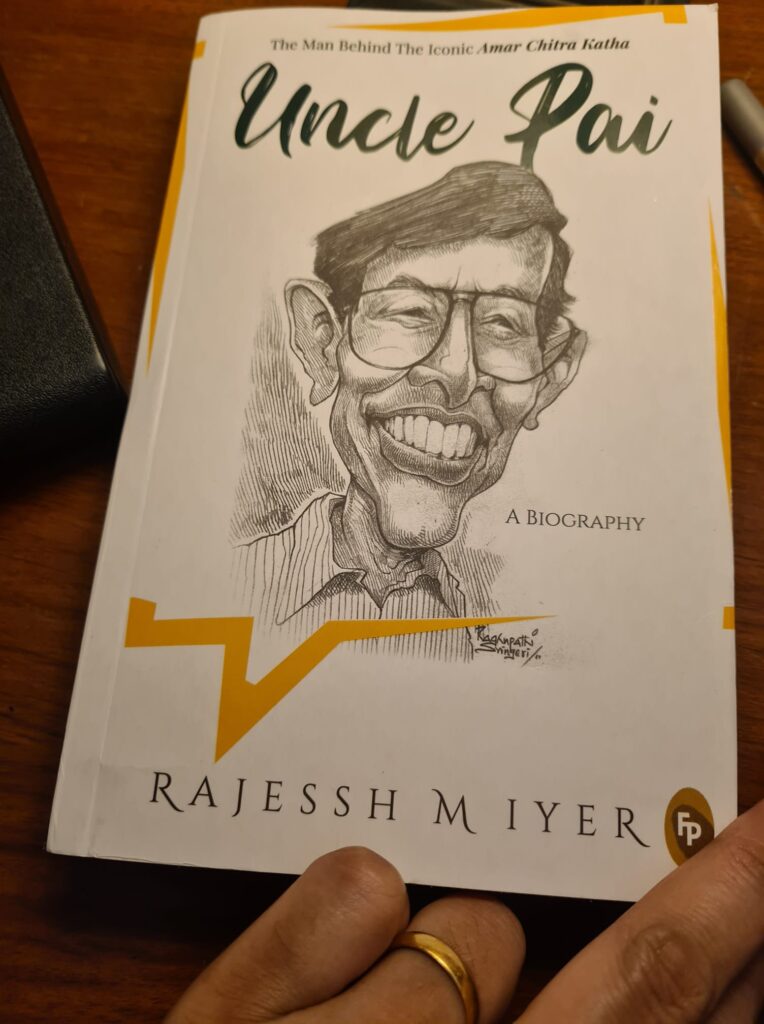 Ramu Damodaran remembers the moment of change. ‘The first time I got a sense of how self-assured he was becoming was when he started referring to himself in third person. He would say, “This is a situation where the prime minister has to act.” That’s when I knew.’ ( p.198)
Ramu Damodaran remembers the moment of change. ‘The first time I got a sense of how self-assured he was becoming was when he started referring to himself in third person. He would say, “This is a situation where the prime minister has to act.” That’s when I knew.’ ( p.198)
Vinay Sitapati’s Half-Lion: How P.V. Narasimha Rao transformed India is a biography of the former prime minister of India. In order to write it the author interviewed many people (some who wished to remain anonymous) and was given access to the private papers of Mr Rao by his family. In the acknowledgements he is grateful to the politician’s family for helping him access the papers “without expecting a hagiography”. In some senses Half-Lion is a straightforward biography documenting the birth-to-death life of a prominent politician despite its overly dramatic opening chapter entitled “Half-burnt body”. Vinay Sitapati meticulously ( at times tediously) records moments in Mr Rao’s life from a landowner-turned-politician of Andhra Pradesh to a powerful politician in Delhi including the few occasions when he was sidelined in politics. Yet it is a fact that Mr Rao was the home minister in 1984 when India ( particularly Delhi) experienced horrendous communal riots following the assassination of Prime Minister Indira Gandhi and later when he himself became prime minister, the Babri Masjid was destroyed leading to widespread communal clashes across India. It was a significant moment in the history of independent India since it marked the rise of the right wing Hindutva forces. Despite this horrendous track record that forever changed the secular fabric of the country there is an undeniable whiff of admiration in Vinay Sitapati’s account of the former prime minister’s role in ushering in liberalisation and transforming the country from a mixed economy and its socialist values of self-reliance to that of free trade. The fact is Mr Rao had no other option except to bring in economic reforms with Manmohan Singh as his finance minister. As journalist Mihir Sharma points out in his column:
…look at his great supposed achievement: the liberalisations of 1991.
The truth is this: in 1991, India had no choice but to reform. Rajiv Gandhi’s over-spending and the oil price crisis pushed India into a corner. Our autarkic industrial and economic policies were unsustainable. Any prime minister with a horizon of more than a few months in office, unlike Rao’s predecessor Chandra Shekhar, would have had to begin the process of opening up India.
What is particularly shameful, however, about calling Rao the “architect of reform” is that Rao did not just do the least he could – but he did it in a craven and dishonourable manner that has doomed the reform process in the decades since.
But did he not provide “political cover” to his team of reformers? No. The centrepoint of the first reform Budget, in 1991, was reform of fertiliser subsidies, which had grown tenfold in cost over the previous decade. The Budget speech quite bluntly reads: “with effect from this evening… there will be an increase of 40 per cent, on an average, in price” of fertiliser. It’s said Manmohan Singh even got Rao’s consent to this particularly difficult reform – the only part of the original 1991 reform process that was actually politically tough – in writing! Naturally, the moment that his Congress MPs raised their eyebrows at this, Rao abandoned his commitment, and it was rolled back. So much for the myth of “political cover”. It has little or no basis in reality.
( Mihir S. Sharma “Don’t praise Rao” Business Standard, 24 June 2016. http://www.business-standard.com/article/opinion/don-t-praise-rao-116062400651_1.html )
The purpose of a biography is to not only record the life of its subject but place it within context. More often than not a biography serves another purpose — that of presenting a period in history as being continuous and particularly in the history of a nation to be stable. As Michael Holroyd points out the golden period of writing literary biographies in Great Britain began in the 1950s and continued till the late 1990s. ( Paris Review, Summer 2013, No. 205 http://www.theparisreview.org/interviews/6223/the-art-of-biography-no-3-michael-holroyd). It is no coincidence that the art of writing biographies that required considerable scholarship and research began in UK soon after the end of World War II. It was a period of reconstruction and establishing the image of united Britain, one nation. Biographies of eminent people helped bolster this image considerably by seeping into the collective consciousness of people. In addition the scope of these biographies allowed exploration and understanding of contemporary historical, socio-political and economic events too. Similarly it is to be hoped that this was part of Vinay Sitapati’s intention with his Half-Lion since the life of Rao coincides with the birth of independent India, a geo-political entity and a significant player in international politics. Also for the many centuries of its existence India till 1947 had never existed like this as one nation state, a united entity, and certainly not for so long — nearly seven decades. So the significance of biographies particularly of politicians takes on a completely new dimension. In fact “in Telenagana, the TRS has adopted Rao as a local icon in a newly formed state looking for regional heroes. Starting in 2014, the Telengana state government has chosen to officially celebrate his birth anniversary in Hyderabad every year. It has announced that Rao’s life will be taught to schoolchildren, and a district and university renamed after him. In 2015, the new BJP Central government built a memorial ghat for Rao in Delhi.” (p.7)
Vinay Sitapati does what a classical biographer would do — “footstepping” in the wake of his subject to determine and recreate a life. But he lacks the craftsmanship of a true biographer in being unable to journey in to the interior life of his subject while being wholly aware of the historical and geographic. Nor is there any moment of self-awareness presumably because the biographer is too much in awe of his subject. Unfortunately despite the magnificent revelations about the internal workings of the Congress party or that of the tenuous relationship between Sonia Gandhi and Mr Rao, Half-Lion blurs the very fine line between a biography and a hagiography. This is a book that will continue to create the ripples it has caused with its publication in late June 2016 and it will be no surprise if this book is optioned for a film.
I interviewed Vinay Sitapati on 4 July 2016 via email. Here is the interview:
- Why Rao? Even after reading your book I am curious to know why this politician? The connect between you and him is missing in Half-Lion and a book of this magnitude requires that pivotal link to keep you going through such a humungous project.
I am a Bandra boy, and have memories growing up through the changes of liberalisation. But I wanted this book to not be about me. The word “I” is not used in the book, and I wanted it to be an honest, objective book, undiluted by the personal impressions I had of the man. I am not a Telugu-speaker, nor did I know Rao. I am just like millions of Indians who were affected by his policies. The power of the book is in this neutrality. I only relied on evidence gleaned from documentary research and interviews, without having any personal opinions or biases. But if you ask me one emotion that kept me going, it was anger: anger that a man as consequential as Rao has been completely ignored by history.
- How many drafts did it take to write Half-Lion?
I completed research and writing of this book in a year. I began in April 2015. After 5 months of research, I began writing. Ramachandra Guha had told me that it takes him about 10-12 days to write a 30-page chapter, once all the research is there. It took me the same. I then circulated the draft of each chapter to about 11 people – from writers and MBA-types to hard-core academics. Their varied feedback both enriched the book and made it accessible to a wide range of readers.
- Before embarking on this project did you research the debates revolving around biographies?
I read about 20 political biographies before I began. I was especially influenced by the book Deng Xiaoping and the Transformation of China by the Harvard historian Ezra Vogel. There were two big debates on biography writing that I learnt from. One: what is the balance between scholarship and accessiblity. This is an academic book, with more than 1100 footnotes. But I’ve also tried to make it fun and simple to read. The second debate was between policy and personality. How much of the book should be about political and policy changes, how much about Rao’s personal life and quirks. Again, I’ve aimed for a balance.
4.Would you want this book turned to a biopic? Or has the book already been optioned for a film?
I have not yet got an offer, but Rao’s life is ripe for a movie. Imagine: in April 1991 he is closing his bank accounts to become a Hindu monk. Two months later, he is the leader of the world’s largest democracy. You can’t make that script up.
- What do you intend to do with the archive you have created while researching this book especially the innumerable interviews you did?
I have done more than 110 interviews. But more than that, it is Rao’s personal archives which are a national treasure. I’m working with his family to put everything online. That way, can access every single thing Rao wrote – public and private – from anywhere in the world. I feel I owe it to my country.
Vinay Sitapati Half-Lion: How P.V. Narasimha Rao transformed India Viking, Penguin Random House, 2016. Hb. pp.390 Rs 699
17 July 2016


